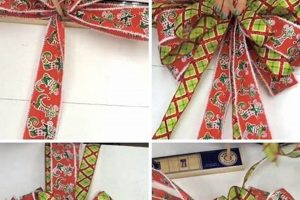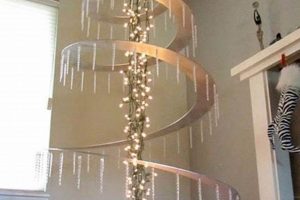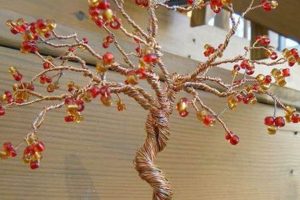The construction of festive evergreen-shaped decorations from reclaimed wooden platforms constitutes a specific segment within holiday crafting. This activity involves disassembling, modifying, and reassembling used shipping skids to create decorative representations typically associated with the winter holiday season. For example, individual planks from a dismantled skid can be cut into progressively shorter lengths, arranged vertically, and secured to a backing to simulate the conical form of a traditional decorated conifer.
Repurposing these readily available materials offers several advantages. It presents a cost-effective alternative to purchasing commercially produced decorations. Furthermore, it contributes to environmentally conscious practices by reducing waste and promoting the reuse of discarded items. The practice also provides opportunities for creative expression and customization, allowing individuals to tailor their holiday dcor to specific aesthetic preferences and spatial constraints. The growing trend reflects a broader interest in sustainable living and personalized home embellishments.
This article will explore the various techniques involved in creating these festive decorations, detailing the necessary tools, safety precautions, and design considerations. Specific attention will be given to surface preparation, cutting and assembly methods, and decorative finishing options to achieve a range of stylistic outcomes.
Essential Construction Advice
The following recommendations are designed to optimize the creation process and ensure the structural integrity and aesthetic appeal of the finished product.
Tip 1: Material Selection: Employ only heat-treated skids, identified by the “HT” stamp. Avoid those marked “MB” (methyl bromide), as this indicates treatment with a toxic fumigant. Prioritize structurally sound planks, free from extensive rot or significant damage.
Tip 2: Proper Disassembly: Utilize appropriate tools, such as a pry bar and hammer, to carefully dismantle the skid. Exercise caution to avoid splintering the wood, and wear safety glasses to protect against flying debris. Consider using a specialized skid dismantling tool for efficiency and safety.
Tip 3: Surface Preparation: Thoroughly clean the wood using a stiff brush and mild detergent to remove dirt and debris. Allow the wood to dry completely before proceeding. Sanding the planks will create a smoother surface for painting or staining.
Tip 4: Precise Cutting: Accurate measurements and clean cuts are crucial for achieving the desired shape. Use a circular saw or jigsaw to cut the planks to the appropriate lengths, ensuring consistent angles for a uniform appearance.
Tip 5: Secure Assembly: Utilize durable fasteners, such as screws or nails, to securely attach the planks to a supporting frame. Consider using wood glue in conjunction with fasteners for added strength and stability. Reinforce joints with metal brackets if necessary.
Tip 6: Aesthetic Considerations: Choose appropriate paints, stains, or finishes to complement the desired aesthetic. Consider applying multiple coats for enhanced durability and a richer color. Utilize stencils or freehand painting techniques to add decorative elements.
Tip 7: Safety First: Always wear appropriate safety gear, including safety glasses, gloves, and a dust mask, when working with wood. Work in a well-ventilated area to minimize exposure to dust and fumes. Ensure that all power tools are in good working order and used according to manufacturer’s instructions.
Adhering to these guidelines will contribute to a safer, more efficient, and ultimately more satisfying construction experience, resulting in a robust and visually appealing decorative item.
With these construction principles established, the subsequent section will address various design strategies.
1. Material Sourcing
The initial stage of constructing festive evergreen-shaped decorations from reclaimed wooden platforms, designated as material sourcing, directly dictates the structural integrity, aesthetic potential, and safety of the final product. The type and condition of the reclaimed shipping skids obtained significantly influence the feasibility and scope of the project. For instance, using chemically treated wood from a repurposed skid exposes inhabitants to potentially harmful volatile organic compounds (VOCs), while utilizing rotted or structurally unsound wood compromises the overall stability of the decorative piece, resulting in early failure or collapse. Therefore, judicious material selection represents a critical step in the construction process.
Consider the instance of a crafting project where skids bearing the “MB” stamp, indicating methyl bromide treatment, are unknowingly utilized. Subsequent off-gassing could create an unhealthy indoor environment. Conversely, selecting skids with the “HT” designation, confirming heat treatment, mitigates such risks. Furthermore, the species of wood affects workability; softwood skids are easier to cut and shape compared to hardwood alternatives, influencing the complexity of the design. Similarly, the dimensions and uniformity of the planks from the original shipping unit determine the final dimensions and aesthetic consistency of the evergreen representation.
In conclusion, effective material sourcing forms the foundation for a successful and safe festive evergreen-shaped decoration from reclaimed wooden platforms project. Careful attention to treatment stamps, structural condition, and wood species not only enhances the visual appeal of the finished product but also protects against potential health hazards and ensures long-term durability, ultimately reinforcing the importance of this initial phase.
2. Design Conceptualization
Design conceptualization constitutes a crucial precursor to the physical construction of evergreen-shaped decorations from reclaimed wooden platforms. It involves translating an abstract idea into a concrete plan that guides the entire construction process. The initial design profoundly influences material selection, construction techniques, and the final aesthetic outcome.
- Scale and Proportion
The chosen dimensions dictate the quantity of reclaimed material required and the structural support necessary. A large-scale representation necessitates more planks and a more robust framework compared to a smaller, tabletop version. Accurate scaling ensures visual harmony and prevents the decoration from appearing disproportionate within its intended environment. For example, a design intended for a small apartment should prioritize verticality over breadth to conserve space, while a design for a large garden might benefit from a wider, more imposing stance.
- Form and Silhouette
Design conceptualization determines the basic shape of the evergreen representation. Traditional triangular forms are readily achievable with incrementally shortened planks, while more stylized or abstract forms require more complex cutting and arrangement techniques. The silhouette can be further modified through the use of varied plank widths and the inclusion of gaps or voids. A design might emulate a specific species of evergreen, such as a fir or a spruce, each possessing a distinct silhouette.
- Style and Theme
The overarching design theme influences material treatments and decorative elements. A rustic design might feature rough-sawn planks, natural finishes, and minimal embellishments, emphasizing the inherent character of the reclaimed wood. Conversely, a modern design might employ smooth, painted surfaces, geometric patterns, and integrated lighting. The chosen theme should complement the surrounding decor. The choice of incorporating lighting can completely affect the mood.
- Functionality and Adaptability
Designs can incorporate functional elements, such as shelving for displaying ornaments or integrated lighting systems. Adaptable designs allow for seasonal modifications, such as removable decorations or interchangeable color schemes. A design might include a sturdy base for supporting heavier ornaments or a modular construction that enables easy disassembly for storage. This forethought enhances usability and ensures its longevity.
In summary, effective design conceptualization is paramount to the successful execution of festive evergreen-shaped decorations from reclaimed wooden platforms. Careful consideration of scale, form, style, and functionality results in a visually appealing, structurally sound, and contextually appropriate decorative element that effectively embodies the holiday spirit. A well-conceived design optimizes the use of reclaimed materials and enhances the overall impact of the finished piece.
3. Structural Integrity
The viability of any evergreen-shaped decoration constructed from reclaimed wooden platforms hinges critically on its structural integrity. The inherent nature of repurposed shipping skids, often subjected to prior stress and environmental exposure, necessitates a design and construction methodology that prioritizes stability and longevity. A failure to address structural concerns can lead to collapse, posing a safety hazard and rendering the decoration unusable. The connection is causational: inadequate design and construction techniques directly lead to compromised stability.
Structural integrity manifests in several practical aspects. The selection of appropriate wood, free from excessive rot or splitting, represents a foundational element. The method of joining individual planks whether through nailing, screwing, or the application of adhesives directly impacts the load-bearing capacity of the overall structure. Furthermore, the inclusion of a robust supporting frame, often constructed from additional wood or metal components, provides essential reinforcement against lateral forces. An example is a large constructed piece placed outdoors; wind loading exerts considerable force, demanding a more robust framework than a similar piece intended for indoor display. Insufficient consideration of these factors can result in warping, leaning, or complete disintegration.
In conclusion, structural integrity constitutes a non-negotiable aspect of successfully creating festive evergreen-shaped decorations from reclaimed wooden platforms. Sound design, material selection, and construction techniques directly correlate with the stability, safety, and long-term usability of the finished product. Overlooking these considerations undermines the entire endeavor, transforming a potentially attractive decoration into a structural liability. Prioritizing this factor ensures a safe and aesthetically pleasing addition to holiday dcor, and a christmas tree pallet diy is an attractive piece of art.
4. Surface Treatment
Surface treatment, in the context of decorations crafted from reclaimed wooden platforms, refers to the modification of the wood’s exterior to enhance its aesthetic appeal, durability, and resistance to environmental factors. This phase is crucial in transforming weathered skids into visually appealing festive decorations and extends the lifespan of the construction.
- Aesthetic Enhancement
Surface treatments alter the visual characteristics of the wood. Paint, stain, or varnish application can dramatically change the color, texture, and sheen of the reclaimed planks. For instance, a whitewashed finish can imbue a rustic aesthetic, while a dark stain can lend a more sophisticated appearance. The choice of treatment directly impacts the overall stylistic impression of the decorative piece and its harmony with the surrounding environment.
- Protection from Environmental Elements
The application of sealants or protective coatings shields the wood from moisture, ultraviolet radiation, and temperature fluctuations. These environmental factors contribute to warping, cracking, and discoloration. Exterior-grade sealants are essential for pieces intended for outdoor display, preventing premature degradation and extending the decoration’s serviceable lifespan. For example, a sealant protects from rotting due to weather changes.
- Textural Modification
Surface treatments can alter the tactile properties of the wood. Sanding creates a smoother, more refined surface, while techniques such as distressing or wire brushing enhance the wood’s natural grain and character. This textural manipulation contributes to the overall sensory experience and can evoke a sense of age or authenticity. A rougher texture gives a rustic feeling.
- Decorative Integration
Surface treatments facilitate the integration of additional decorative elements. Paint serves as a base for stenciled designs, hand-painted motifs, or adhered embellishments. Stains can highlight the wood grain, providing a natural backdrop for added features. Specific paints may enhance the overall design.
The strategic selection and application of surface treatments are integral to the successful creation of festive evergreen-shaped constructions from reclaimed wooden platforms. These treatments transcend mere aesthetic considerations, contributing to the structural integrity, longevity, and overall impact of the finished decoration.
5. Decorative Detailing
In the context of decorations fashioned from reclaimed wooden platforms, the term decorative detailing encompasses the addition of embellishments and modifications beyond the basic structural form. This phase is paramount in transforming a rudimentary wooden structure into a visually compelling and personalized festive element.
- Ornamentation
This facet includes the attachment of external adornments such as baubles, tinsel, ribbons, or handcrafted ornaments. The choice of ornamentation directly impacts the overall aesthetic and thematic resonance of the decorative piece. For example, traditional glass ornaments evoke a sense of classic holiday charm, while rustic wooden ornaments complement the reclaimed nature of the material. The density and arrangement of ornaments significantly influence the visual impact.
- Illumination
The incorporation of lighting systems, ranging from simple string lights to integrated LED arrays, introduces a dynamic element. Illumination accentuates the form of the decoration, creates atmospheric effects, and enhances its visibility. Warm white lights often evoke a cozy, traditional ambiance, while colored lights can introduce a more contemporary or whimsical feel. The method of light integration, whether draped externally or embedded within the structure, also contributes to the overall aesthetic.
- Surface Embellishment
This category encompasses techniques that modify the surface of the wood itself, such as painting, stenciling, carving, or the application of decoupage. These embellishments add layers of visual complexity and allow for a high degree of personalization. For instance, stenciled snowflakes or hand-painted holiday scenes can transform a plain wooden surface into a festive tableau. The choice of colors, patterns, and textures significantly impacts the visual character of the decoration.
- Material Accents
The integration of non-wooden materials, such as burlap, metal accents, or natural elements like pinecones and branches, introduces textural contrast and enhances the overall aesthetic. These accents can reinforce the rustic character of the reclaimed wood or introduce a contrasting element of sophistication. For example, burlap ribbon adds a touch of homespun charm, while metallic stars provide a contrasting element of glamour.
These facets, when thoughtfully integrated, elevate a basic reclaimed wooden platform decoration into a unique and expressive representation of the holiday spirit. The skillful application of decorative detailing transforms a simple structure into a focal point, reflecting personal style and contributing to the overall festive atmosphere.
6. Spatial Integration
Spatial integration, regarding constructions from reclaimed wooden platforms, denotes the mindful consideration of a decorative item’s placement within a defined environment to achieve visual harmony and functional suitability. Its importance becomes apparent when noting how the size, style, and overall design of a fabricated piece interact with its surroundings. Failure to consider these factors risks visual discord, functional obstruction, or even safety hazards. This element is crucial for creations involving repurposed skids, due to their often irregular dimensions and inherently rustic aesthetic. Placement without forethought can result in a piece that clashes with existing decor or obstructs pathways.
Practical applications involve carefully assessing the available space and selecting a design that complements its dimensions. A large, sprawling construction may be well-suited for a spacious garden, but it becomes visually overwhelming in a small apartment. Conversely, a slender, minimalist version may be appropriate for a compact living room but appear insignificant in a grand foyer. Style considerations are equally important. A rustic, weathered design might be ideal for a farmhouse-style setting, while a sleek, painted design could integrate more seamlessly into a modern environment. Furthermore, functional aspects must be considered: proximity to electrical outlets for illuminated designs, stability on uneven surfaces, and clearance from high-traffic areas to prevent accidental damage or injury.
The challenges of spatial integration often lie in the inherent variability of reclaimed wooden platforms. Dimensions are inconsistent, and aesthetic characteristics are unpredictable. Overcoming these challenges necessitates adaptability and a willingness to modify the original design to suit the specific environment. Understanding this interconnectivity provides a framework for transforming discarded materials into cohesive decorative components, enhancing both the aesthetic appeal of the setting and the overall appreciation of the handcrafted item.
Frequently Asked Questions
The following section addresses common inquiries regarding the construction of festive evergreen-shaped decorations from reclaimed wooden platforms.
Question 1: Is using reclaimed wood from shipping skids safe for indoor decorations?
The safety depends on the treatment applied to the skid. Skids marked “HT” (heat treated) are generally safe for indoor use. Avoid skids marked “MB” (methyl bromide), a toxic fumigant. Thoroughly clean and sand the wood before using it indoors.
Question 2: What are the essential tools required for a decoration project involving recycled wooden skids?
Essential tools include a pry bar for disassembly, a saw (circular or jigsaw) for cutting, a drill/driver for assembly, sandpaper for smoothing, safety glasses, gloves, and a dust mask.
Question 3: How does one ensure the structural stability of a tall decoration made from reclaimed wood?
Structural stability is ensured through a robust supporting frame, secure fastening methods (screws and glue), and careful attention to weight distribution. Reinforce joints with metal brackets for added stability.
Question 4: What type of finish is most suitable for an outdoor decoration constructed from recycled wood?
For outdoor decorations, use exterior-grade paints or sealants to protect against moisture, UV radiation, and temperature fluctuations. Reapply sealant annually to maintain protection.
Question 5: How does one prevent splintering when cutting reclaimed wood skids?
To minimize splintering, use a sharp blade, cut slowly, and apply masking tape along the cut line. Sanding after cutting also helps to remove splinters.
Question 6: What are some design considerations for maximizing space in small living areas?
Optimize vertical space with a tall, narrow design. Minimize the base footprint to avoid obstructing pathways. Utilize light colors to create a sense of spaciousness.
These FAQs are intended as a guide and are not a substitute for professional woodworking advice.
The subsequent section will address safety considerations.
Conclusion
The preceding discussion has elucidated the various facets involved in crafting evergreen-shaped decorations from reclaimed wooden platforms. From material sourcing and design conceptualization to structural considerations, surface treatments, decorative detailing, and spatial integration, each element plays a critical role in the successful execution of these festive creations. Adherence to these principles facilitates the transformation of discarded materials into aesthetically pleasing and structurally sound decorative items.
The construction of these decorations requires mindful planning, careful execution, and a commitment to safety. By embracing these principles, individuals can contribute to sustainable practices while creating unique and personalized holiday dcor. Further exploration of advanced construction techniques and innovative design approaches will undoubtedly continue to evolve this field, enabling even more sophisticated and environmentally conscious applications.







